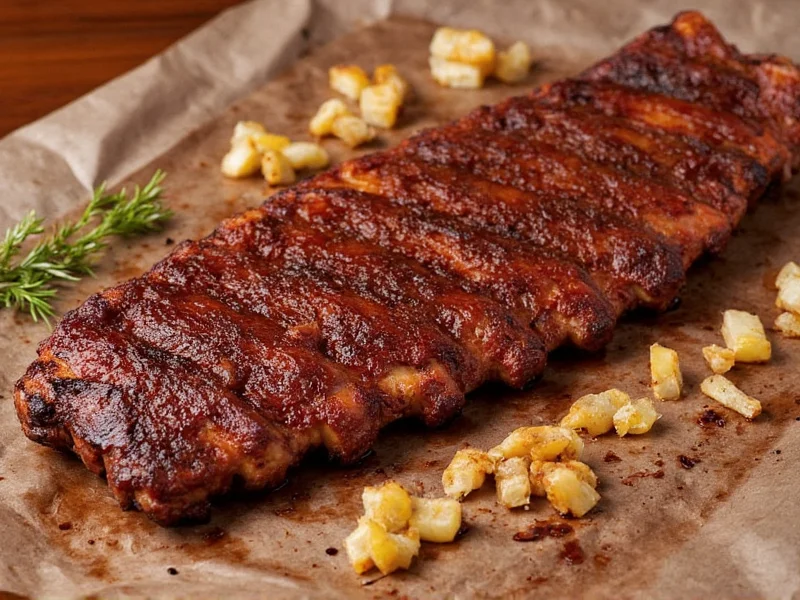Understanding the distinction between St. Louis-style ribs and spare ribs is essential for both novice grillers and experienced pitmasters. While these cuts share the same origin on the pig, specific preparation methods create notable differences in appearance, cooking behavior, and eating experience.
What Are Spare Ribs?
Spare ribs come from the belly section of the pig, specifically the lower portion of the rib cage near the belly. Butchers cut them from the section that remains after removing the belly to make bacon. Traditional spare ribs include 11-13 bones and feature:
- Irregular, rectangular shape with a curved end
- Substantial fat content throughout the meat
- Bone structure that includes the sternum (breastbone)
- Rib tips attached (the chewy cartilage section at one end)
- Generally more marbling than other rib cuts
What Defines St. Louis-Style Ribs?
St. Louis-style ribs aren't a naturally occurring cut—they're actually spare ribs that have been precisely trimmed to create a uniform shape. Butchers remove:
- The sternum (breastbone) section
- The rib tips (cartilaginous portion)
- Excess fat and cartilage
This meticulous trimming creates the signature square shape that makes St. Louis ribs popular for competitive barbecue, where presentation matters as much as flavor. The process typically reduces a full rack of spare ribs from 11-13 bones down to 8-10 perfectly aligned bones.
| Characteristic | Spare Ribs | St. Louis-Style Ribs |
|---|---|---|
| Origin on Pig | Lower belly section | Trimmed spare ribs |
| Shape | Irregular rectangle with curved end | Square, uniform shape |
| Bone Count | 11-13 bones | 8-10 bones |
| Fat Content | Higher fat content | Moderate fat (excess trimmed) |
| Cooking Time | Slightly longer due to extra fat | More consistent cooking |
| Flavor Profile | Richer, fattier taste | Cleaner pork flavor |
| Price | Generally less expensive | Higher cost due to trimming |
Cooking Implications of the Difference
The structural differences between these two cuts significantly impact cooking approaches. Spare ribs' irregular shape and higher fat content mean they require careful attention to prevent uneven cooking. The rib tips often cook faster than the meatier portion, potentially leading to overcooked sections if not monitored.
St. Louis-style ribs' uniform shape creates more predictable cooking results, making them ideal for competition barbecue where consistent doneness across the entire rack matters. Their cleaner edges also allow for more precise application of rubs and sauces. Many pitmasters find St. Louis ribs easier to handle on the grill or smoker, especially for beginners learning proper barbecue techniques.
Flavor and Texture Comparison
Spare ribs deliver a richer, fattier eating experience due to their higher marbling. The additional fat renders during cooking, basting the meat internally and creating exceptionally tender results when prepared properly. This makes spare ribs particularly satisfying for those who enjoy a more substantial, traditional rib experience.
St. Louis-style ribs offer a leaner profile with meat distributed more evenly across the bones. The trimming process removes some of the fattier portions, resulting in a cleaner pork flavor that allows seasoning rubs and sauces to shine through more distinctly. The meat-to-bone ratio remains excellent, providing satisfying portions without the chewier cartilage sections found in untrimmed spare ribs.
When to Choose Which Cut
Selecting between these rib varieties depends on your cooking goals and preferences:
Choose spare ribs when:
- You prefer a more traditional, rustic rib presentation
- You want maximum fat content for exceptionally tender results
- You're cooking for a crowd on a budget (spare ribs typically cost less)
- You enjoy the chewy texture of rib tips
Opt for St. Louis-style ribs when:
- You're preparing ribs for a competition or special occasion
- You want uniform cooking results with less monitoring
- You prefer a leaner meat profile with cleaner presentation
- You're serving guests who might be intimidated by irregular shapes
Common Misconceptions Clarified
Many home cooks confuse spare ribs with baby back ribs, but these are distinctly different cuts. Baby backs come from higher on the pig's back near the loin, resulting in smaller, more curved bones with less fat. Understanding the difference between St. Louis ribs vs spare ribs helps avoid this common mix-up.
Another frequent misunderstanding involves preparation methods. Some believe St. Louis ribs require different cooking techniques, but they respond well to the same low-and-slow approach as spare ribs—typically 225-250°F for 5-6 hours. The main adjustment needed is slightly reduced cooking time due to their leaner composition.











 浙公网安备
33010002000092号
浙公网安备
33010002000092号 浙B2-20120091-4
浙B2-20120091-4